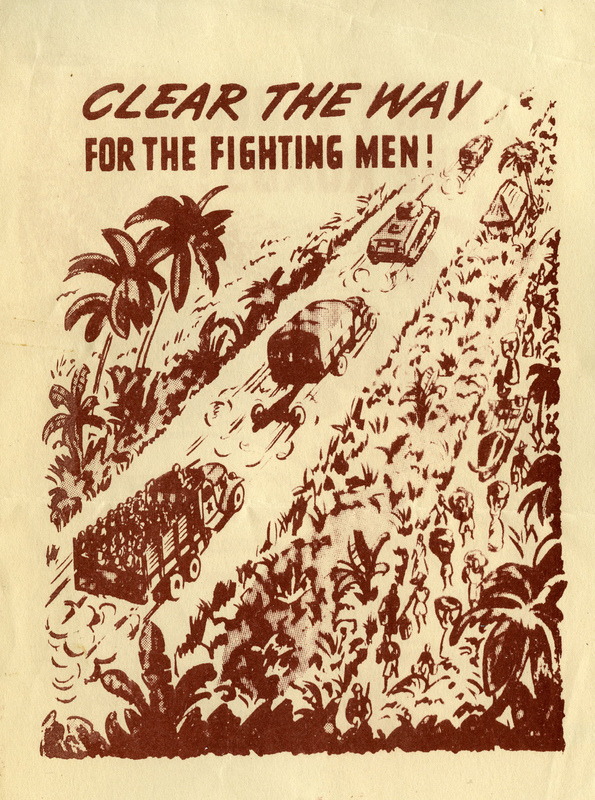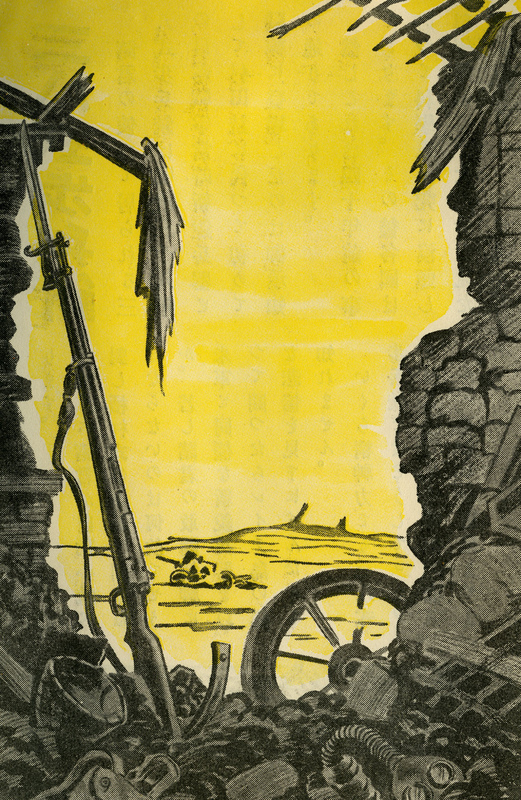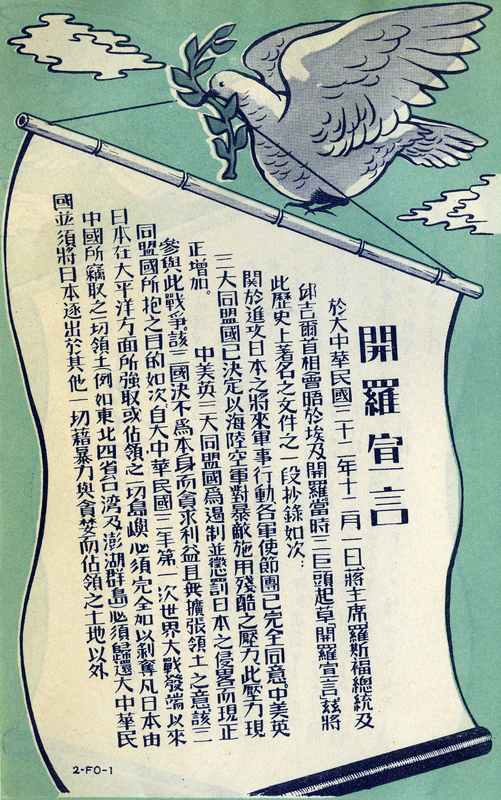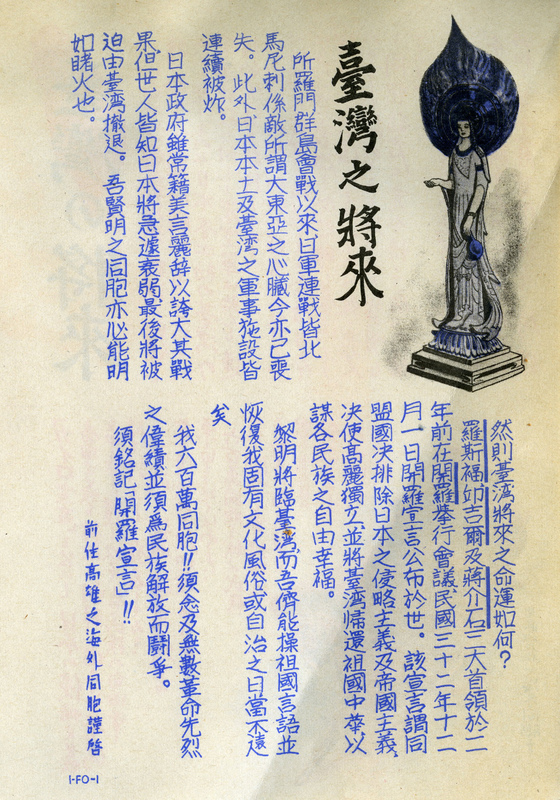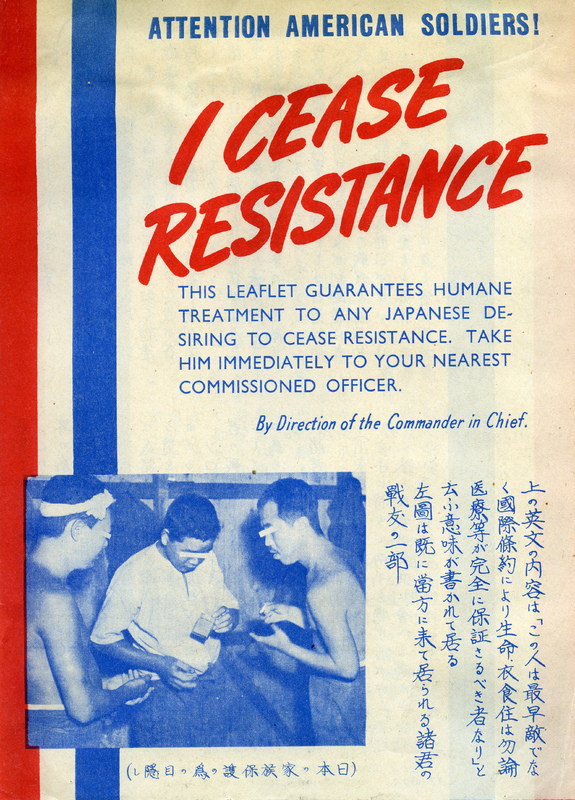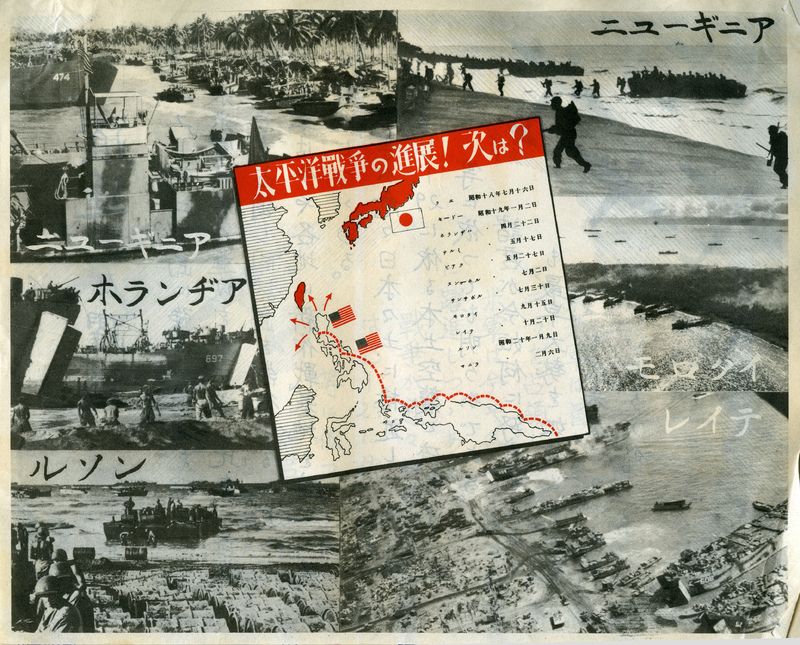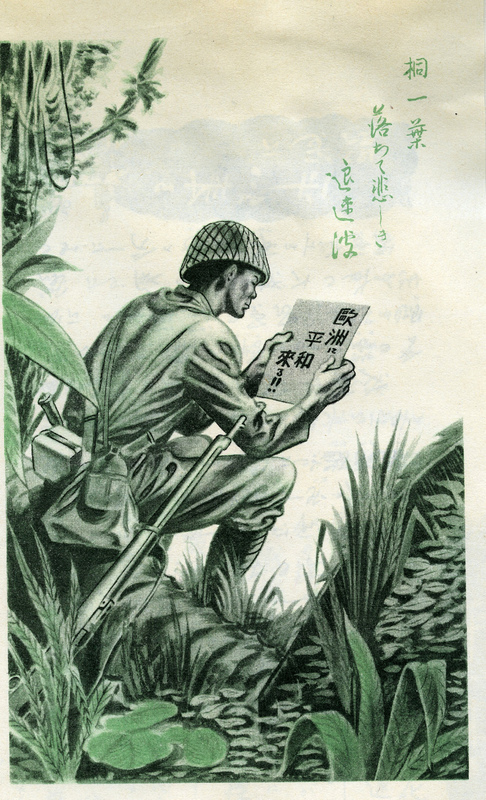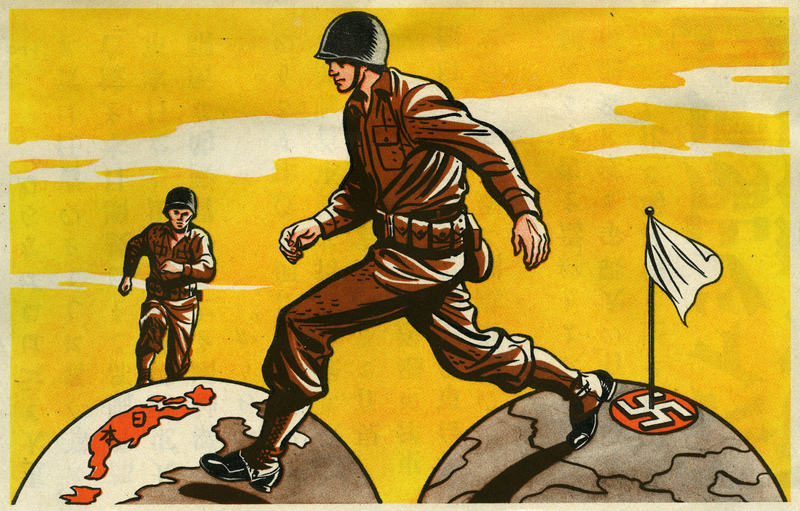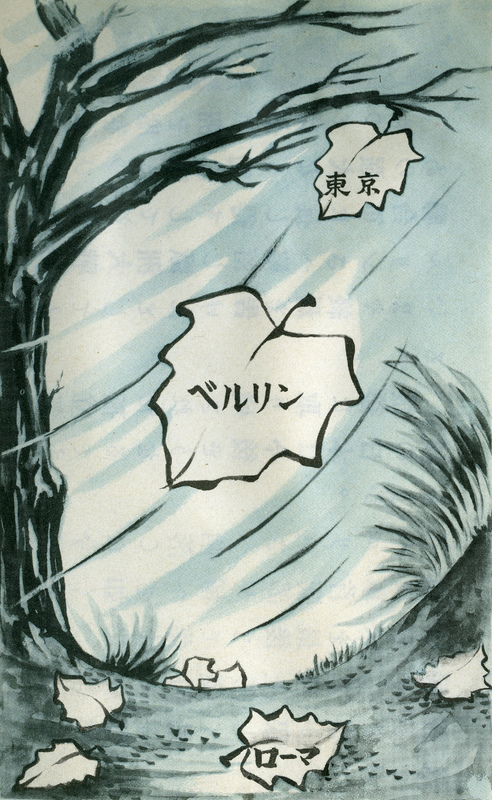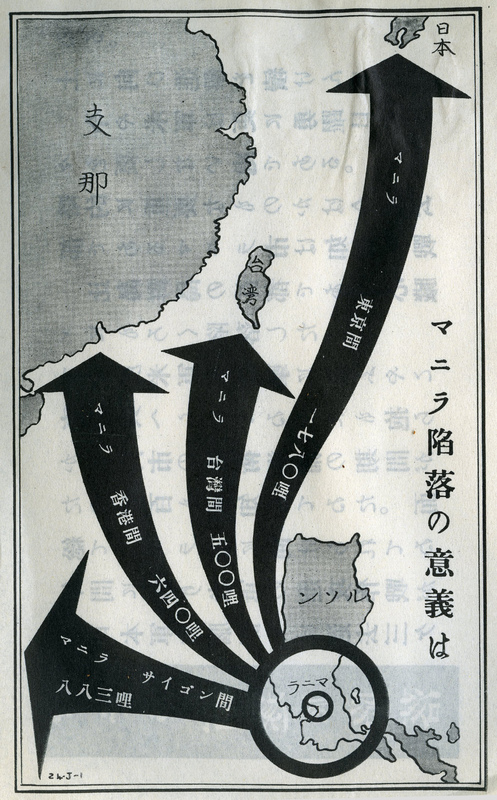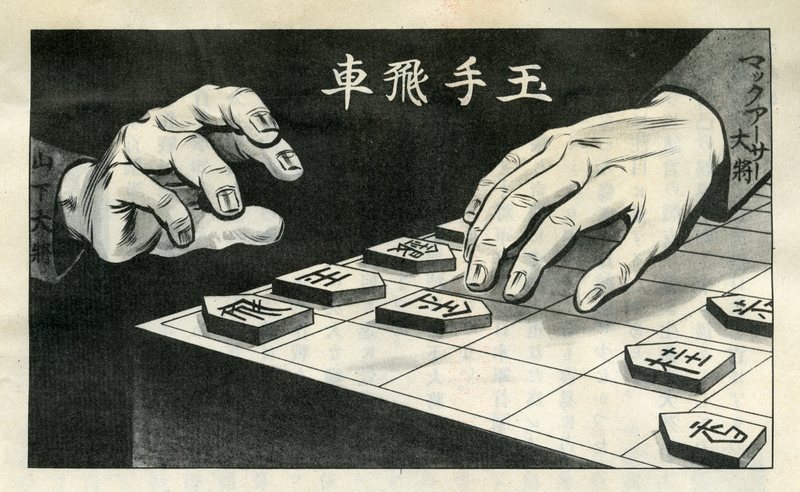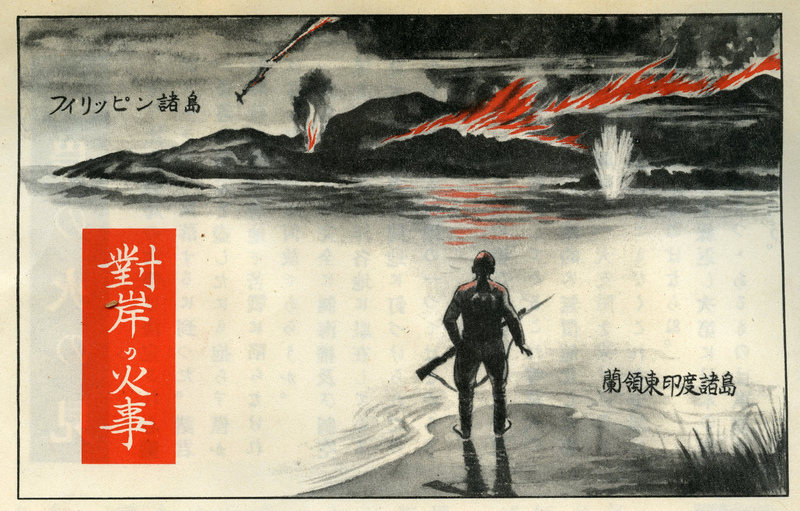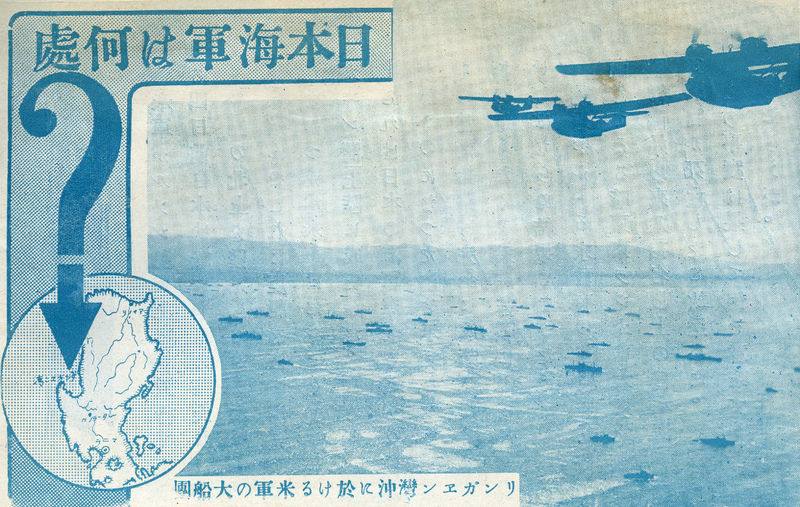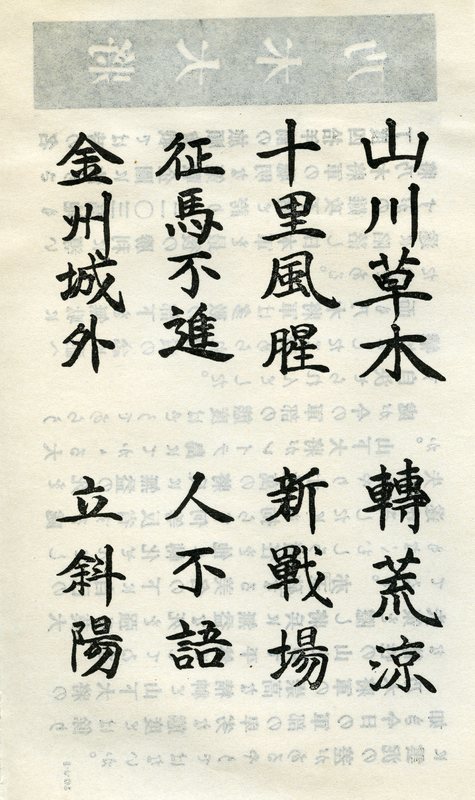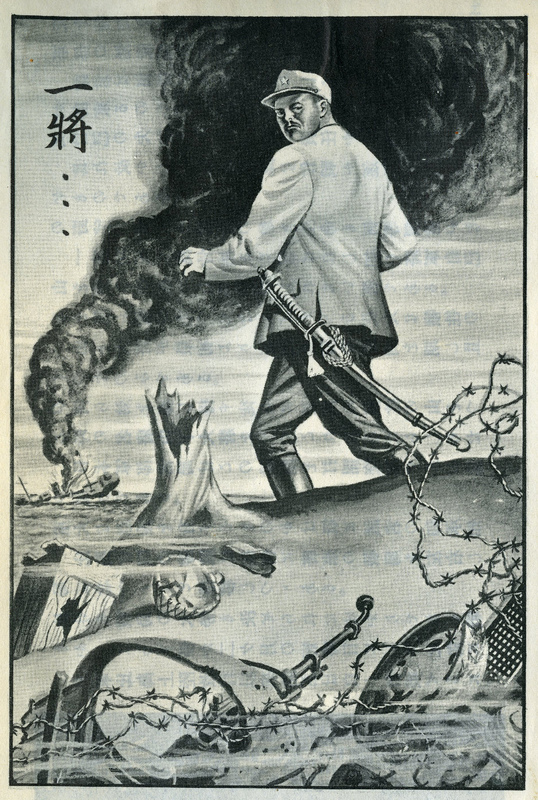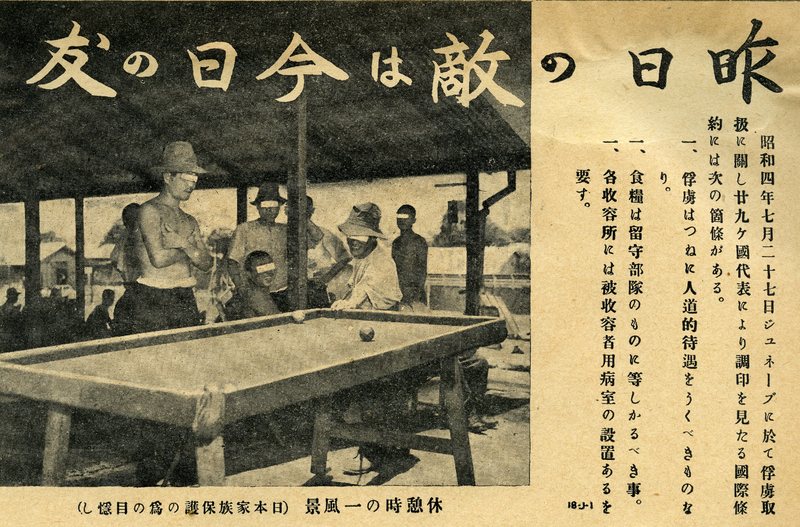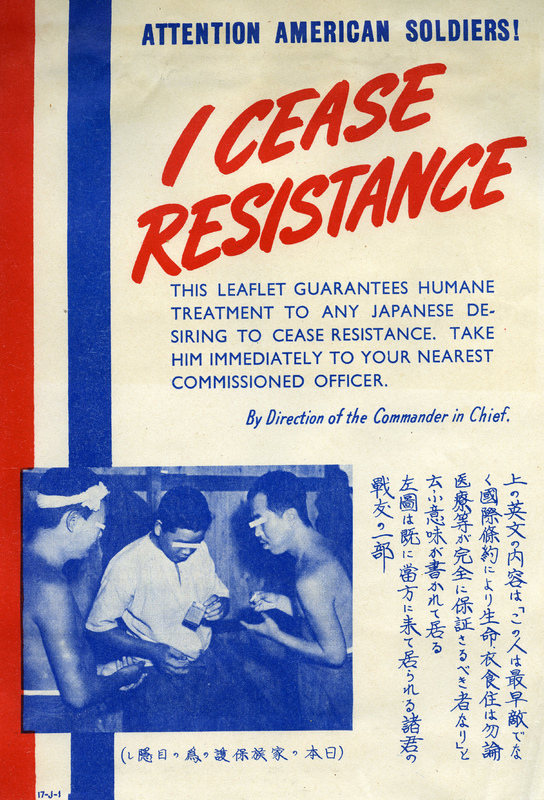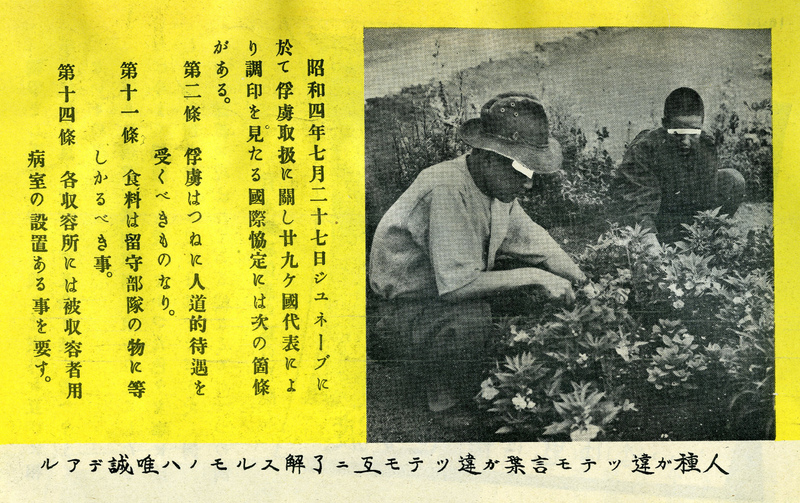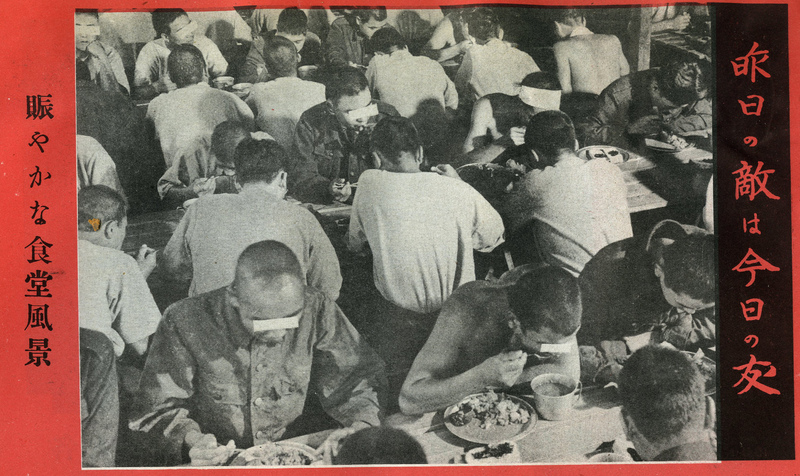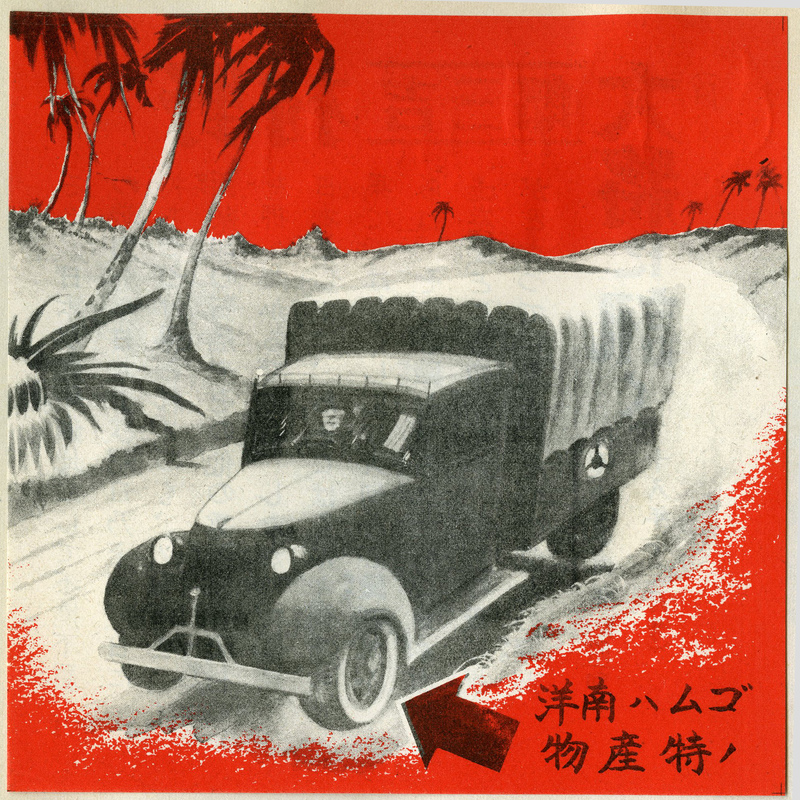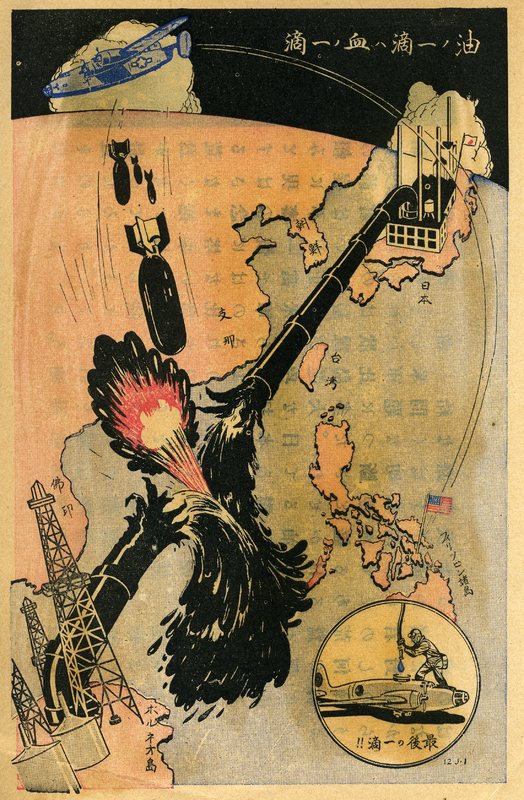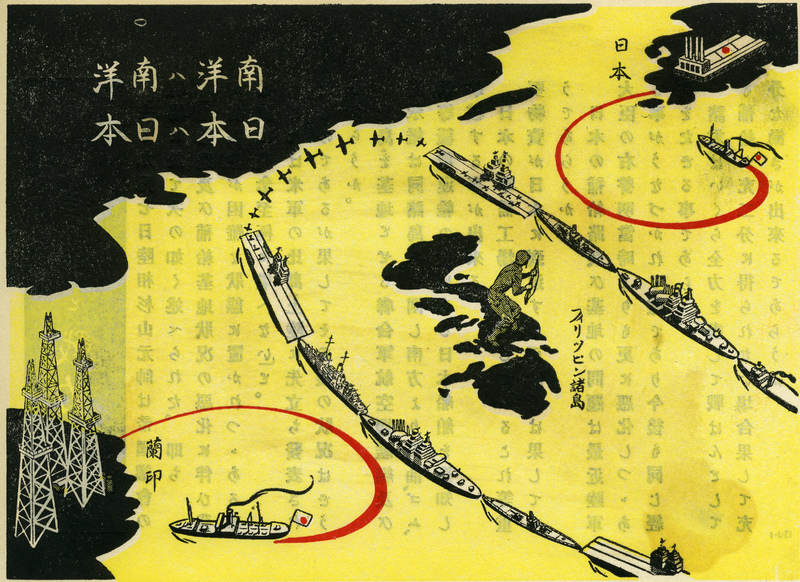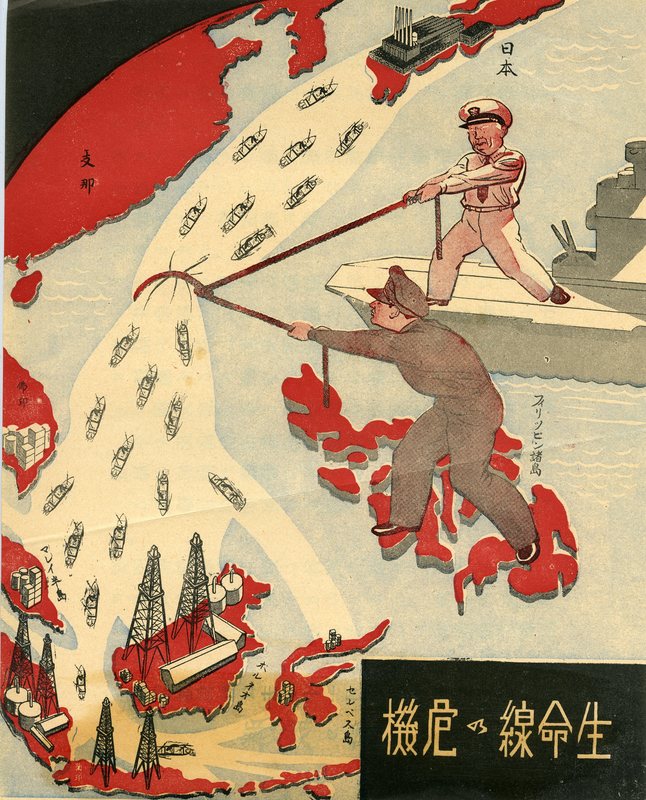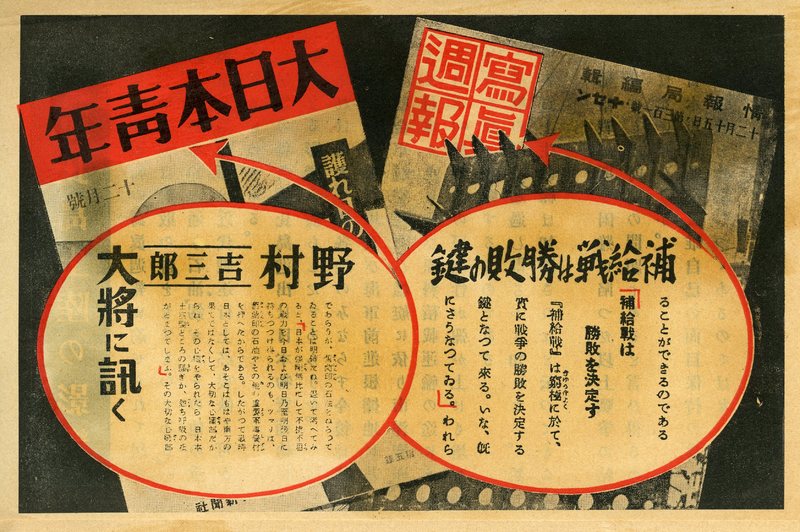WWII Propaganda Leaflets from the Baldwin Scrapbook
- Title
- WWII Propaganda Leaflets from the Baldwin Scrapbook
- Description
- The Psychological Warfare Branch of the United States Armed Forces was a military unit that created and distributed propaganda during the Second World War. The scrapbook contains approximately 200 pieces of their propaganda, mostly in Japanese, that were intended for distribution in the Philippines, Japan, and other nearby areas. Each item is accompanied by a typed translation into English. Pacific University Archives MS.70
Items
-
'Clear the Way for the Fighting Men' flierA flier issued by the Allied Forces during World War II after the return of General Douglas MacArthur and President Osmena to the Philippine Islands. The flier was probably airdropped to the citizens of the Philippine Islands soon after General MacArthur and President Osmena landed in October, 1944. It contained instructions for Filipinos to keep the roads clear for the American troops. This is one item from a scrapbook of propaganda leaflets and related materials that was compiled by the Psychological Warfare Branch of the Allied Forces in the Southwest Pacific Area during World War II. The scrapbook belonged to Colonel Karl F. Baldwin of the United States Army, who helped establish the propaganda program. It contains approximately 200 pieces of propaganda, mostly in Japanese, that were intended for distribution in the Philippines, Japan, and other nearby areas.
-
'Type 38 Rifle' propaganda leafletA propaganda leaflet issued by the Allied Forces during World War II after the return of General Douglas MacArthur to the Philippine Islands in 1944. The leaflets were probably airdropped to the Japanese troops on the Philippine Islands soon after General MacArthur landed in October, 1944. One side features an illustration of destruction on a battlefield, with a Type 38 rifle amongst the carnage. The other side features text explaining that the Type 38 rifle was useful 40 years ago, but is now far inferior to the Allied Forces weapons. The leaflets were intended to create a sense of helplessness by causing the Japanese to lose confidence in their weapons and induce the surrender of Japanese troops. It is numbered '33-J-1'. The leaflet is accompanied by an official description and translation of the text into English. This is one item from a scrapbook of propaganda leaflets and related materials that was compiled by the Psychological Warfare Branch of the Allied Forces in the Southwest Pacific Area during World War II. The scrapbook belonged to Colonel Karl F. Baldwin of the United States Army, who helped establish the propaganda program. It contains approximately 200 pieces of propaganda, mostly in Japanese, that were intended for distribution in the Philippines, Japan, and other nearby areas.
-
'Cairo Declaration' flierA paper flier issued by the Allied Forces for the people of the Island of Formosa during World War II after the return of General Douglas MacArthur to the Philippine Islands. The flier was probably air dropped soon after General MacArthur landed in October, 1944. The text is written in Chinese on one side and Japanese on the other side. The flier explains the Cairo Declaration and the status afforded to Formosa following the end of Japanese occupation. It was intended to inform the people of Formosa of the Allied Forces post-war aims with regards to the Island of Formosa. It is numbered '2-FO-1'. The flier is accompanied by an official description and translation of the text into English. This is one item from a scrapbook of propaganda leaflets and related materials that was compiled by the Psychological Warfare Branch of the Allied Forces in the Southwest Pacific Area during World War II. The scrapbook belonged to Colonel Karl F. Baldwin of the United States Army, who helped establish the propaganda program. It contains approximately 200 pieces of propaganda, mostly in Japanese, that were intended for distribution in the Philippines, Japan, and other nearby areas.
-
'Future of Formosa' flierA paper flier issued by the Allied Forces for the people of Formosa during World War II after the battle for Manila 1945. The flier was probably airdropped on Formosa soon after the battle for Manila ended in March, 1945. It is written in Chinese on one side and Japanese on the other. It features an image of the Chinese war god on one side and a Chinese religious figure on the other. The flier describes the Allied Forces victories in the Solomon Islands and Manila, and the likelyhood of the Japanese troops retreat from Formosa. It explains the status that Formosa will have once the Japanese have left the island of Formosa, according to the Cairo Declaration. The intent of this leaflet was to give the people of Formosa hope of liberation. The flier is numbered '1-FO-1'. It is accompanied by an official description and translation of the text into English. This is one item from a scrapbook of propaganda leaflets and related materials that was compiled by the Psychological Warfare Branch of the Allied Forces in the Southwest Pacific Area during World War II. The scrapbook belonged to Colonel Karl F. Baldwin of the United States Army, who helped establish the propaganda program. It contains approximately 200 pieces of propaganda, mostly in Japanese, that were intended for distribution in the Philippines, Japan, and other nearby areas.
-
'I Cease Resistance' propaganda leafletA propaganda leaflet issued by the Allied Forces during World War II after the return of General Douglas MacArthur to the Philippine Islands in 1944. The leaflets were probably airdropped to Japanese troops on the Philippine Islands soon after General MacArthur landed in October, 1944. One side features a Japanese soldier that has surrendered being treated well by the Americans. The other side explains that the International Law is followed by the Americans, and any Japanese soldier that surrenders will be treated well. The leaflets were meant to induce the surrender of Japanese troops by demonstrating the treatment they will receive after surrendering. It is numbered '17-(A)-J-1'. The leaflet is accompanied by an official description and translation of the text into English. This is one item from a scrapbook of propaganda leaflets and related materials that was compiled by the Psychological Warfare Branch of the Allied Forces in the Southwest Pacific Area during World War II. The scrapbook belonged to Colonel Karl F. Baldwin of the United States Army, who helped establish the propaganda program. It contains approximately 200 pieces of propaganda, mostly in Japanese, that were intended for distribution in the Philippines, Japan, and other nearby areas.
-
'One Stride After Another' propaganda leafletA propaganda leaflet issued by the Allied Forces during World War II soon after the successful battle of Iwo Jima in March, 1945. The leaflets were probably airdropped to Japanese troops on the Philippine Islands. One side features photographs of Allied Forces victories with a list of their advances. The other side explains the Allied Forces advances are bringing them closer to the Japanese homeland. The intent of the leaflet was to demoralize Japanese troops by pointing out their weaknesses, with the hope of inducing their surrender. It is numbered '32-J-1'. The leaflet is accompanied by an official description and translation of the text into English. This is one item from a scrapbook of propaganda leaflets and related materials that was compiled by the Psychological Warfare Branch of the Allied Forces in the Southwest Pacific Area during World War II. The scrapbook belonged to Colonel Karl F. Baldwin of the United States Army, who helped establish the propaganda program. It contains approximately 200 pieces of propaganda, mostly in Japanese, that were intended for distribution in the Philippines, Japan, and other nearby areas.
-
'Peace in Europe' propaganda leafletA propaganda leaflet issued by the Allied Forces during World War II after the end of the war in Europe in 1945. The leaflets were probably airdropped to Japanese troops on the Philippine Islands soon after the war ended in Europe in May, 1945. One side features an illustration of a Japanese soldier reading a paper with the headline 'The European War Has Ended'. The other side features text describing the peace in Europe and the end of hunger, carnage and battle. It states that men will soon be reunited with their families. The intent of the leaflet was to demoralize Japanese troops by pointing out their weaknesses, with the hope of inducing their surrender. It is numbered '28-J-1'. The leaflet is accompanied by an official description and translation of the text into English. This is one item from a scrapbook of propaganda leaflets and related materials that was compiled by the Psychological Warfare Branch of the Allied Forces in the Southwest Pacific Area during World War II. The scrapbook belonged to Colonel Karl F. Baldwin of the United States Army, who helped establish the propaganda program. It contains approximately 200 pieces of propaganda, mostly in Japanese, that were intended for distribution in the Philippines, Japan, and other nearby areas.
-
'Fall of Germany' propaganda leafletA propaganda leaflet issued by the Allied Forces during World War II after the fall of Berlin in 1945. The leaflets were probably airdropped to Japanese troops, soon after the fall of Berlin in May, 1945. One side features an illustration of Allied troops leaving Germany and stepping towards Japan, symbolizing the Allied Forces leaving defeated Germany and heading for Japan. The other side features text stating that Germany has fallen and now the full focus of the Allied Forces would shift to Japan. The intent of the leaflet was to demoralize Japanese troops by pointing out their weaknesses, with the hope of inducing their surrender. It is numbered '27-J-1'. The leaflet is accompanied by an official description and translation of the text into English. This is one item from a scrapbook of propaganda leaflets and related materials that was compiled by the Psychological Warfare Branch of the Allied Forces in the Southwest Pacific Area during World War II. The scrapbook belonged to Colonel Karl F. Baldwin of the United States Army, who helped establish the propaganda program. It contains approximately 200 pieces of propaganda, mostly in Japanese, that were intended for distribution in the Philippines, Japan, and other nearby areas.
-
'Fall of Berlin' propaganda leafletA propaganda leaflet issued by the Allied Forces during World War II after the fall of Berlin in 1945. The leaflets were probably airdropped to Japanese troops, soon after the fall of Berlin in May, 1945. One side features an illustration of a leaf falling off of a Paulownia tree with 'Berlin' written on it. A leaf with 'Rome' written on it lays on the ground, while a leaf with 'Tokyo' written on it remains on the tree. The other side features a message about the fall of Berlin and the once great German army. It puts blame on the Japanese military leaders for their destruction of land and their sacrificing of Japanese lives. The intent of the leaflet was to demoralize Japanese troops by pointing out their weaknesses, with the hope of inducing their surrender.It is numbered '26-J-1'. The leaflet is accompanied by an official description and translation of the text into English. This is one item from a scrapbook of propaganda leaflets and related materials that was compiled by the Psychological Warfare Branch of the Allied Forces in the Southwest Pacific Area during World War II. The scrapbook belonged to Colonel Karl F. Baldwin of the United States Army, who helped establish the propaganda program. It contains approximately 200 pieces of propaganda, mostly in Japanese, that were intended for distribution in the Philippines, Japan, and other nearby areas.
-
'Manilla has Fallen' propaganda leafletA propaganda leaflet issued by the Allied Forces during World War II, soon after their successful invasion of Manila. The leaflets were airdropped to Japanese troops on the Philippine Islands soon after the Allied Forces took control of Manila in March, 1945. The front features an image of Manila on a map, with arrows leading from Manila to areas close by. It was intended to show the strategic location of Manila to other Japanese strongholds. The back announces that the Allied Forces have successfully taken over control of Manila. While explaining that the American troops are in high morale and are ready to strike again. The intent of the leaflet was to demoralize Japanese troops by pointing out their weaknesses, with the hope of inducing their surrender. It is numbered '24-J-1'. The leaflet is accompanied by an official description and translation of the text into English. This is one item from a scrapbook of propaganda leaflets and related materials that was compiled by the Psychological Warfare Branch of the Allied Forces in the Southwest Pacific Area during World War II. The scrapbook belonged to Colonel Karl F. Baldwin of the United States Army, who helped establish the propaganda program. It contains approximately 200 pieces of propaganda, mostly in Japanese, that were intended for distribution in the Philippines, Japan, and other nearby areas.
-
'Two Strategies' propaganda leafletA propaganda leaflet issued by the Allied Forces during World War II after their successful invasion of the Lingayen Gulf in 1945. The leaflets were probably airdropped to Japanese troops on the Philippine Islands soon after the Allied Forces victory in the Lingayen Gulf in January, 1945. One side features an image of two men playing chess, with the names MacArthur and Yamashita on their sleeves. The image contains the word 'Checkmate' at the top. The other side describes General Douglas MacArthur's dominance over General Yamashita. The intent of the leaflet was to demoralize Japanese troops by pointing out their weaknesses, with the hope of inducing their surrender. It is numbered '23J1'. The leaflet is accompanied by an official description and translation of the text into English. This is one item from a scrapbook of propaganda leaflets and related materials that was compiled by the Psychological Warfare Branch of the Allied Forces in the Southwest Pacific Area during World War II. The scrapbook belonged to Colonel Karl F. Baldwin of the United States Army, who helped establish the propaganda program. It contains approximately 200 pieces of propaganda, mostly in Japanese, that were intended for distribution in the Philippines, Japan, and other nearby areas.
-
'Watching Fires on the Further Shore' propaganda leafletA propaganda leaflet issued by the Allied Forces during World War II after the successful invasion of the Ling.ayen Gulf in 1945. The leaflets were probably airdropped to Japanese troops on the Philippine Islands soon after the Allied Forces victory in the Lingayen Gulf in January, 1945. The front contains an image of a lone Japanese soldier watching the battle in the Lingayen Gulf from afar. The back contains a message to Japanese troops. The intent of the leaflet was to demoralize Japanese troops by pointing out their weaknesses, with the hope of inducing their surrender. It is numbered '22J1'. The leaflet is accompanied by an official description and translation of the text into English. This is one item from a scrapbook of propaganda leaflets and related materials that was compiled by the Psychological Warfare Branch of the Allied Forces in the Southwest Pacific Area during World War II. The scrapbook belonged to Colonel Karl F. Baldwin of the United States Army, who helped establish the propaganda program. It contains approximately 200 pieces of propaganda, mostly in Japanese, that were intended for distribution in the Philippines, Japan, and other nearby areas.
-
'Japanese Fleet' propaganda leafletA propaganda leaflet issued by the Allied Forces during World War II after the successful invasion of the Lingayen Gulf in 1944. The leaflets were probably airdropped to Japanese troops on the Philippine Islands soon after the Allied Forces victory in the Lingayen Gulf in January, 1945. One side features an image of the American invasion convoy in the Lingayen Gulf, with the words 'Where is the Japanese Fleet?'. The other side has statements about the battle and the Japanese losses, with particular emphasis on the loss of Japanese supply routes. The intent of the leaflet was to demoralize Japanese troops by pointing out their weaknesses, with the hope of inducing their surrender. It is numbered '21J1'. The leaflet is accompanied by an official description and translation of the text into English. This is one item from a scrapbook of propaganda leaflets and related materials that was compiled by the Psychological Warfare Branch of the Allied Forces in the Southwest Pacific Area during World War II. The scrapbook belonged to Colonel Karl F. Baldwin of the United States Army, who helped establish the propaganda program. It contains approximately 200 pieces of propaganda, mostly in Japanese, that were intended for distribution in the Philippines, Japan, and other nearby areas.
-
'General Nogi' propaganda leafletA propaganda leaflet issued by the Allied Forces during World War II after the return of General Douglas MacArthur to the Philippine Islands in 1944. The leaflets were probably airdropped to Japanese troops on the Philippine Islands soon after General MacArthur landed in October, 1944. One side features a poem written by Japanese General, Yamashita. The other side questions the Japanese military leaders, their responsibility for Japanese troops deaths and the lack of responsibility taken by General Yamashita. This leaflet was meant to drive a wedge between Japanese troops and their commanders with the hope of inducing the surrender of Japanese troops. It is numbered '20J1'. The leaflet is accompanied by an official description and translation of the text into English. This is one item from a scrapbook of propaganda leaflets and related materials that was compiled by the Psychological Warfare Branch of the Allied Forces in the Southwest Pacific Area during World War II. The scrapbook belonged to Colonel Karl F. Baldwin of the United States Army, who helped establish the propaganda program. It contains approximately 200 pieces of propaganda, mostly in Japanese, that were intended for distribution in the Philippines, Japan, and other nearby areas.
-
'One General' propaganda leafletA propaganda leaflet issued by the Allied Forces during World War II after the return of General Douglas MacArthur to the Philippine Islands in 1944. The leaflets were probably airdropped to Japanese troops on the Philippine Islands soon after General MacArthur landed in October, 1944. One side features an image of Japanese General, Yamashita, walking away from a battlefield in defeat. The back side of the leaflet condemns General Yamashita for sacrificing so many Japanese troops. The leaflet is meant to drive a wedge between the Japanese troops and their military commanders with the hopes of inducing the surrender of Japanese troops. It is numbered '19J1'. It is accompanied by an official description and translation of the text into English. This is one item from a scrapbook of propaganda leaflets and related materials that was compiled by the Psychological Warfare Branch of the Allied Forces in the Southwest Pacific Area during World War II. The scrapbook belonged to Colonel Karl F. Baldwin of the United States Army, who helped establish the propaganda program. It contains approximately 200 pieces of propaganda, mostly in Japanese, that were intended for distribution in the Philippines, Japan, and other nearby areas.
-
'Yesterday we were Enemies, Today we are Friends' propaganda leafletA propaganda leaflet issued by the Allied Forces during World War II after the return of General Douglas MacArthur to the Philippine Islands in 1944. The leaflets were probably airdropped to Japanese troops on the Philippine Islands soon after General MacArthur landed in October, 1944. One side of the leaflet features an image of Japanese prisoners of war playing a game of pool. The other side of the leaflet emphasizes the good treatment of Japanese prisoners of war in accordance to the International Law. It was meant to induce the surrender of Japanese troops by demonstrating that the Allied Forces would treat prisoners of war humanely according to the International Law. The leaflet is numbered '18J1'. It is accompanied by an official description and translation of the text into English. This is one item from a scrapbook of propaganda leaflets and related materials that was compiled by the Psychological Warfare Branch of the Allied Forces in the Southwest Pacific Area during World War II. The scrapbook belonged to Colonel Karl F. Baldwin of the United States Army, who helped establish the propaganda program. It contains approximately 200 pieces of propaganda, mostly in Japanese, that were intended for distribution in the Philippines, Japan, and other nearby areas.
-
'I Cease Resistance' propaganda leafletA propaganda leaflet issued by the Allied Forces during World War II after the return of General Douglas MacArthur to the Philippine Islands in 1944. The leaflets were probably airdropped to Japanese troops on the Philippine Islands soon after General MacArthur landed in October, 1944. It was meant to induce the surrender of Japanese troops by demonstrating the humane treatment troops will receive by the Allied Forces. It explains that prisoners of war will be treated humanely according to the articles of the International Law. The leaflet is numbered '17J1'. It is accompanied by an official description and translation of the text into English. This is one item from a scrapbook of propaganda leaflets and related materials that was compiled by the Psychological Warfare Branch of the Allied Forces in the Southwest Pacific Area during World War II. The scrapbook belonged to Colonel Karl F. Baldwin of the United States Army, who helped establish the propaganda program. It contains approximately 200 pieces of propaganda, mostly in Japanese, that were intended for distribution in the Philippines, Japan, and other nearby areas.
-
'Good Treatment of Prisoners' propaganda leafletA propaganda leaflet issued by the Allied Forces during World War II after the return of General Douglas MacArthur to the Philippine Islands in 1944. The leaflets were probably airdropped to Japanese troops on the Philippine Islands soon after General MacArthur landed in October, 1944. It features images of Japanese prisoners of war, depicting them eating and working in a garden. The leaflet list three articles from the International Law on the treatment of prisoners. It was meant to induce the surrender of Japanese troops by demonstrating that the Allied Forces would treat prisoners of war humanely according to the International Law. It is numbered '16J1'. The leaflet is accompanied by an official description and translation of the text into English. This is one item from a scrapbook of propaganda leaflets and related materials that was compiled by the Psychological Warfare Branch of the Allied Forces in the Southwest Pacific Area during World War II. The scrapbook belonged to Colonel Karl F. Baldwin of the United States Army, who helped establish the propaganda program. It contains approximately 200 pieces of propaganda, mostly in Japanese, that were intended for distribution in the Philippines, Japan, and other nearby areas.
-
'Good Treatment of Prisoners' propaganda leafletA propaganda leaflet issued by the Allied Forces during World War II after the return of General Douglas MacArthur to the Philippine Islands in 1944. The leaflets were probably airdropped to Japanese troops on the Philippine Islands soon after General MacArthur landed in October, 1944. It features photographs of Japanese prisoners of war. The leaflet states that Japanese prisoners are provided with food, clothing, shelter, medical care and recreation in accordance with the International Law. It was meant to induce surrender of Japanese troops by demonstrating the treatment troops would receive once they surrendered. The leaflet is numbered '15J1'. The leaflet is accompanied by an official description and translation of the text into English. This is one item from a scrapbook of propaganda leaflets and related materials that was compiled by the Psychological Warfare Branch of the Allied Forces in the Southwest Pacific Area during World War II. The scrapbook belonged to Colonel Karl F. Baldwin of the United States Army, who helped establish the propaganda program. It contains approximately 200 pieces of propaganda, mostly in Japanese, that were intended for distribution in the Philippines, Japan, and other nearby areas.
-
'Tools of War' propaganda leafletsA series of propaganda leaflets issued by the Allied Forces during World War II after the return of General Douglas MacArthur to the Philippine Islands. The leaflets were probably airdropped to Japanese troops on the Philippine Islands soon after General MacArthur returned in October, 1944. The series of leaflets stresses the importance of the natural resources that Japan receives from the South Seas. Without these resources Japan cannot win the war. The intent of the leaflet was to demoralize Japanese troops by pointing out their weaknesses, with the hope of inducing their surrender. The leaflets are numbered '14J1'. They are accompanied by an official description and translation of the text into English. This is one item from a scrapbook of propaganda leaflets and related materials that was compiled by the Psychological Warfare Branch of the Allied Forces in the Southwest Pacific Area during World War II. The scrapbook belonged to Colonel Karl F. Baldwin of the United States Army, who helped establish the propaganda program. It contains approximately 200 pieces of propaganda, mostly in Japanese, that were intended for distribution in the Philippines, Japan, and other nearby areas.
-
'Pipeline' propaganda leafletA propaganda leaflet issued by the Allied Forces during World War II after the return of General Douglas MacArthur to the Philippine Islands in 1944. The leaflets were probably airdropped on Japanese troops on the Philippine Islands soon after General MacArthur returned in October, 1944. It explains the importance of oil in the South Pacific for the Japanese. It states that the Americans have sunk Japanese ships containing oil and this will soon affect the Japanese war effort. The intent of the leaflet was to demoralize Japanese troops by pointing out their weaknesses, with the hope of inducing their surrender. It is numbered '12J1'. The leaflet is accompanied by an official description and translation of the text into English. This is one item from a scrapbook of propaganda leaflets and related materials that was compiled by the Psychological Warfare Branch of the Allied Forces in the Southwest Pacific Area during World War II. The scrapbook belonged to Colonel Karl F. Baldwin of the United States Army, who helped establish the propaganda program. It contains approximately 200 pieces of propaganda, mostly in Japanese, that were intended for distribution in the Philippines, Japan, and other nearby areas.
-
'Ring of Ships' propaganda leafletA propaganda leaflet issued by the Allied Forces during World War II after the return of General Douglas MacArthur to the Philippine Islands in 1944. The leaflets were probably airdropped to Japanese troops on the Philippine Islands soon after General MacArthur landed in October, 1944. It uses an excerpt from the Japanese War Minister Marshal, Sugiyama, in which he states the importance of the supply lines in the South Pacific. The leaflet explains that the Americans have since surrounded the Philippine Islands and are destroying Japanese supply lines. The intent of the leaflet was to demoralize Japanese troops by pointing out their weaknesses, with the hope of inducing their surrender. The leaflet is numbered '13J1'. It is accompanied by an official description and translation of the text into English. This is one item from a scrapbook of propaganda leaflets and related materials that was compiled by the Psychological Warfare Branch of the Allied Forces in the Southwest Pacific Area during World War II. The scrapbook belonged to Colonel Karl F. Baldwin of the United States Army, who helped establish the propaganda program. It contains approximately 200 pieces of propaganda, mostly in Japanese, that were intended for distribution in the Philippines, Japan, and other nearby areas.
-
'Japan's Life Line' propaganda leafletA propaganda leaflet issued by the Allied Forces during World War II after the return of General Douglas MacArthur to the Philippine Islands in 1944. The leaflets were probably airdropped to Japanese troops on the Philippine Islands soon after General MacArthur landed in October, 1944. It used an excerpt from the Domei News Agency about the importance of the Japanese supply line. The leaflet goes on to explain that the supply line is now in danger with General Douglas MacArthur and Admiral Chester Nimitz in command of Philippine bases. The intent of the leaflet was to demoralize Japanese troops by pointing out their weaknesses, with the hope of inducing their surrender. The leaflet is numbered '10J1'. It is accompanied by an official description and translation of the text into English. This is one item from a scrapbook of propaganda leaflets and related materials that was compiled by the Psychological Warfare Branch of the Allied Forces in the Southwest Pacific Area during World War II. The scrapbook belonged to Colonel Karl F. Baldwin of the United States Army, who helped establish the propaganda program. It contains approximately 200 pieces of propaganda, mostly in Japanese, that were intended for distribution in the Philippines, Japan, and other nearby areas.
-
'War of Supply' propaganda leafletA propaganda leaflet issued by the Allied Forces during World War II after the return General Douglas MacArthur to the Philippine Islands. The leaflets were probably airdropped on the Philippine Islands to Japanese troops still fighting, soon after General MacArthur landed in October, 1944. It states that raw materials that are essential to winning the war will not be able to pass through the allied forces that now occupy the Philippine Islands. The intent of the leaflet was to demoralize Japanese troops by pointing out their weaknesses, with the hope of inducing their surrender. It is numbered '8J1'. It is accompanied by an official description and translation of the text into English. This is one item from a scrapbook of propaganda leaflets and related materials that was compiled by the Psychological Warfare Branch of the Allied Forces in the Southwest Pacific Area during World War II. The scrapbook belonged to Colonel Karl F. Baldwin of the United States Army, who helped establish the propaganda program. It contains approximately 200 pieces of propaganda, mostly in Japanese, that were intended for distribution in the Philippines, Japan, and other nearby areas.

